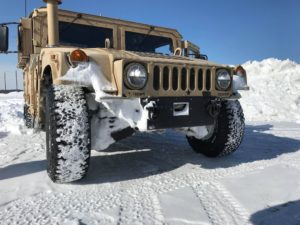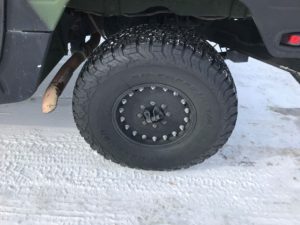By Jerry Aliotta
June 24, 2021
DETROIT ARSENAL, Mich.—Driving safely on icy roads can be challenging, not to mention frightening, even perilous. Having proper tire traction can make all the difference in avoiding a crash and arriving at your destination safe and sound.

Test data indicates that Soldiers are more confident about driving on snowy and icy terrains when BF Goodrich KO2 tires are installed on their vehicles. (U.S. Army photo/Released)
There’s good news for Soldiers driving HMMWVs, or High Mobility Multipurpose Wheeled Vehicles, on icy and snowy roads. It’s called the BF Goodrich KO2 tire with a three-peak mountain snowflake (3PMSF) rating, a symbol branded on a tire’s sidewall indicating the product meets required performance criteria to be considered severe-snow service-rated.
In short, the KO2 tire has optimum traction on snowy and icy terrains.
“The winter tires resulted in a significant increase in traction over the standard HMMWV tire,” said Sebastian K. Karwaczynski, Ph.D., Lead Safety Engineer for Joint Light Tactical Vehicles and U.S. Army Ground Vehicle Systems Center (GVSC).
Last December, Product Director Light Tactical Vehicles (PdD LTV) partner Cold Regions Research and Engineering Laboratory (CRREL) collected test results on the KO2s.
The data indicated significant improvement in both lateral acceleration and traction force, as measured by drawbar pull, which basically means the pulling force, or pulling ability, of a vehicle. This data provided PdD LTV the confidence it needed to move out and provide sample winter tire-wheel sets to its partner, U.S. Army Alaska’s 17th Combat Sustainment Support Battalion (CSSB).
In March, as part of the HMMWV Winter Tire program, PdD LTV, along with GVSC and CRREL engineers and experts, teamed with the 17th CSSB Soldiers to take part in winter tire evaluations in Alaska.
Soldiers put the winter tires to the test on HMMWVs on Alaska’s hard-packed snow roads, driving from Joint Base Elmendorf-Richardson to Fort Wainwright and back. Then they shared their experiences, providing critical insight into how they liked or disliked the tires.
Data indicates that Soldiers are more confident when the Goodrich KO2 tire were installed. Chief Warrant Officer 2 Jason McConnell, 17th CSSB, drove an M1151 HMMWV with the winter tires for about 20 miles and put them through some tough work.
“I actually tried to get them to fail but they did not,” McConnell said. “The only time they slid was when I applied extreme pressure to the brakes.”
While KO2 tires don’t have quite the same traction as standard tires with chains, Karwaczynski said installing chains is time-consuming for Soldiers and significantly limits vehicle speed.
“Additionally, the tires with chains must be rechecked every mile, a situation which puts Soldiers in harm’s way,” Karwaczynski said.
To improve tactical wheeled vehicle mobility in severe winter areas, Col. Adam Lange, Deputy Commander of Sustainment in Alaska, who uses KO2s on his privately owned vehicle, said he wants to see HMMWVs equipped with KO2s prior to next winter.
“I’d like to have NSNs [National Stock Numbers] for these tires by October, so they can be ordered and available for use by winter,” Lange said.
Not only are KO2s 3PMSF rated, they are also all-season tires.

Test data indicates that Soldiers are more confident about driving on snowy and icy terrains when BF Goodrich KO2 tires are installed on their vehicles. (U.S. Army photo/Released)
“That means they can be utilized all year round, eliminating the need to change the wheel assemblies out once the weather breaks and the ice melts,” Karwaczynski said.
Improving the HMMWV’s capability to handle winter driving conditions supports the DOD’s Arctic Strategy.
The Arctic, a vital area containing many of our nation’s natural resources and key shipping channels, is a platform for projecting global power and a possible avenue of attack in conflict. This enhanced Arctic capability will increase the Army’s ability to operate in extreme cold-weather, mountainous and high-latitude environments.
“The Arctic is an opportunity to rapidly employ the speed, range and convergence of cutting-edge technologies being developed for Multi-Domain Operations to strengthen our deterrence capabilities in the region,” said Gen. James McConville, Chief of Staff of the Army, at the time the strategy was implemented in June 2019.
Additionally, because the modern design of the KO2 winter tire has resulted in lower rolling resistance, Karwaczynski said HMMWV’s fuel economy has improved, based on the recent test data.
Next steps for the program include continued durability and reliability testing this summer at the Nevada Automotive Test Center (NATC) in Carson City, Nev., and is anticipated to be favorable, Karwaczynski said.







